This post may contain affiliate links, please view our disclosure policy for more details.
It’s that time!
You’re ready to send your little one off to daycare – an emotional time to say the least! It also comes with a whole new set of challenges (for you and them).
Figuring out what to pack in your baby’s lunch for daycare is one of them and it can be stressful – even more so if it’s your first baby. There’s a lot to think about and plan when packing lunches, depending on how long your baby spends at daycare during the day, you may need more than just a lunch, like additional snacks and beverages.

But don’t stress! We’re here to help you figure out what to pack in your little one’s lunch other than jarred baby food every day! I’m going to explain all the considerations you need to make when packing daycare lunches for your little one and share my recommendations for must-have lunch gear with you. We’ll also explore 20+ mix-and-match lunch combinations that are easy for you to pack and prepare, plus are nutritious and delicious for your little one.
Ready? Let’s dig into all the details!
If you’re feeling overwhelmed about starting solids and you’re not sure where to begin, join our FREE workshop – How to start solids: A realistic first week of feeding your baby. This workshop is for parents ready to feel confident and prepared to start solids—without all the guesswork.
Learn exactly what to feed, when to feed it, and how to do it—step-by-step—with expert guidance from pediatric dietitian, Edwena Kennedy. Plus, get a FREE 5 day meal plan just for attending!
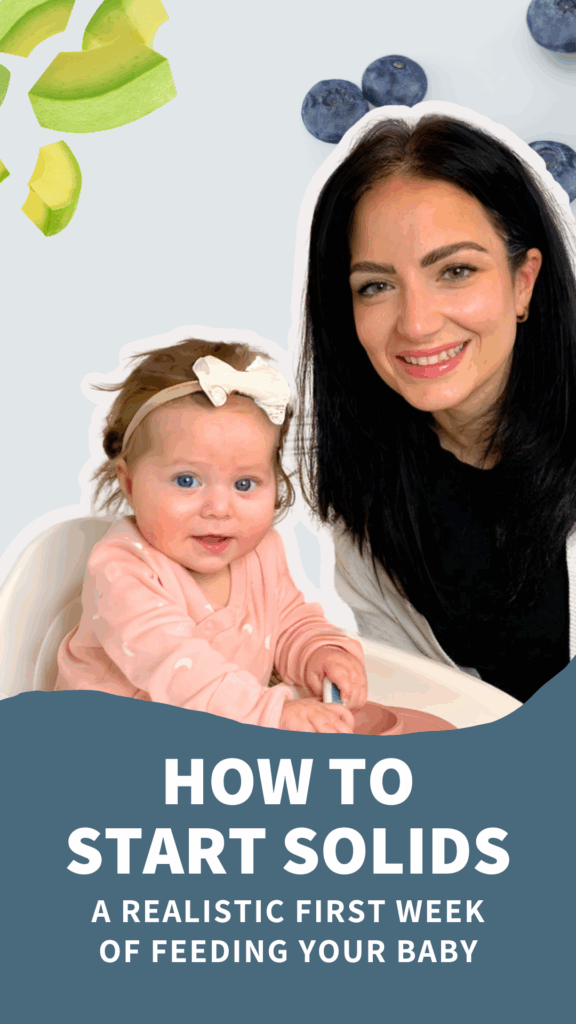
Table of Contents
If you want to be sure your baby is getting nutritionally balanced and nutrient-dense lunches at daycare, and for meals at home too, check out my 60 Day Baby Led Feeding Meal Plan – you’ll get access to over 80 recipes that are perfect for starting solids, and that the whole family can enjoy.
This isn’t just a regular meal plan with a list of recipes, you’ll actually be able to follow along with the plan to strategically introduce allergens, advance your baby in textures, and ensure all nutrient needs are being met.
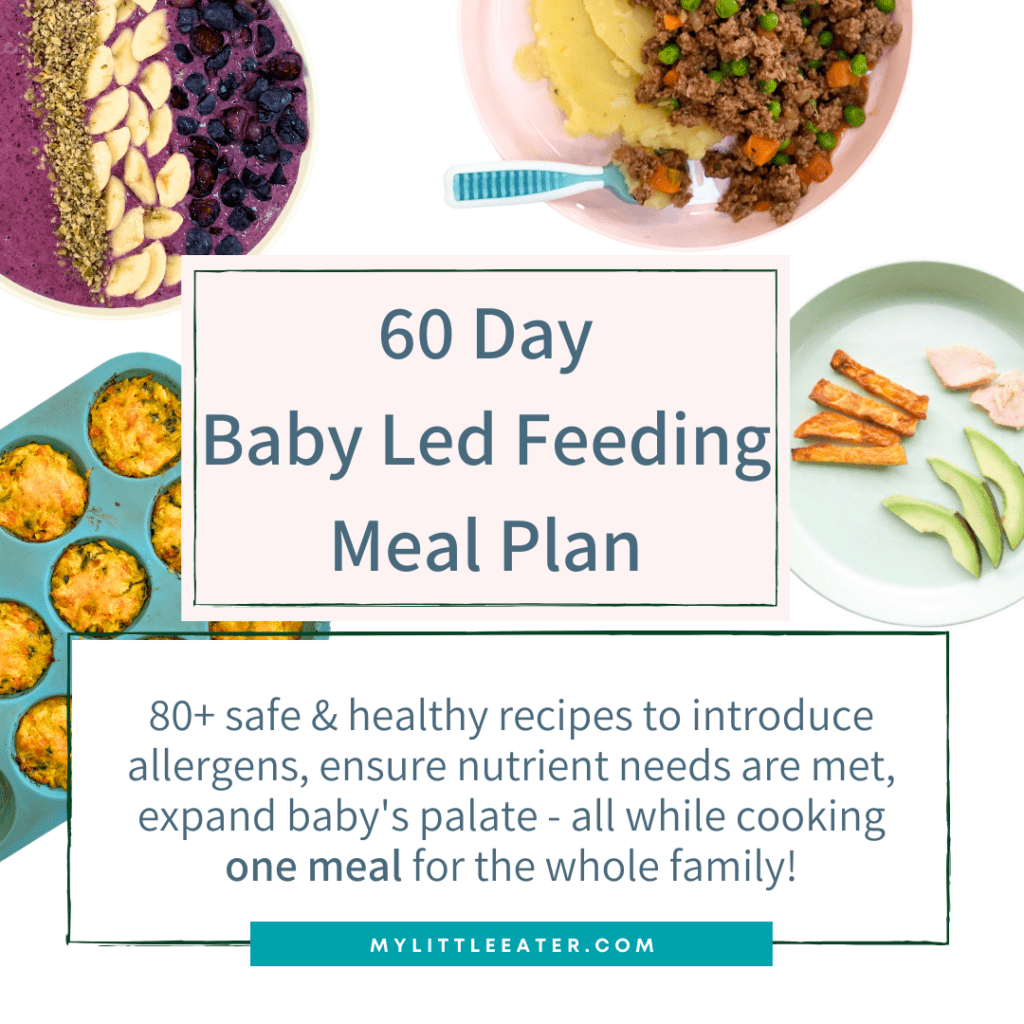
What types of food to include in daycare lunches

Low-mess foods
While messy foods can be fun at home, they’re not as ideal in a daycare setting when there are multiple babies and toddlers to clean up after the meal has ended! For this reason, we recommend avoiding or minimizing the following:
- Broth or very thin, liquidy sauces that don’t stick easily to a spoon (like 0% regular yogurt)
- Things that stain easily (ie. beets or cherry tomatoes)
- Super crumbly food that falls apart easily (think loose rice!)

Of course, you can still pack them from time to time! But focus on keeping it to a minimum or using appropriate substitutes, like thicker sauces to add moisture to certain foods to make sure it’s safe for baby. For example, if you pack pasta, keep it simple (with olive oil or butter) or use a thicker option like hummus that will stick to noodles and minimize mess. If you pack yogurt, opt for full-fat Greek yogurt, which is thicker and sticks to a spoon easier!
A little bit of mess is ok (we LOVE mess at home!), but we just want to keep it manageable for those at daycare taking care of your little ones! You can also just pack those foods and use a full-body bib to keep clean-up minimal!
Peanut-free foods

Most daycares and school facilities are peanut-free, so you’ll want to be cautious when packing lunches for your little one. If you’re sending any prepackaged snacks, carefully read the ingredients list to ensure it does not contain peanuts, and choose foods that are labeled as “peanut-free” when possible.
Of course, there may be another allergen other than peanuts that you need to avoid sending to daycare (or perhaps peanuts aren’t even on the list!). Our recommendation is to find out this information in advance by asking the facility for any allergy guidelines to help keep everyone safe.
High-calorie foods

I’m sure you’ve already come to the realization that your little one’s appetite can fluctuate on a day-to-day basis, which is totally normal. Various other factors may also impact their appetite, like being in a new daycare environment, getting sick more frequently from being around other children, distractions from other children at daycare, and more!
If your little one may not be eating as much at daycare as they would be at home, packing a variety of nutrient-dense foods and building balanced meals versus food with empty calories, such as puffs, crackers, and/or fast-dissolving baby snacks, is best. Plus, balanced meals that are nutrient-dense are guaranteed to keep your little one full for longer, so you don’t need to worry about them going hungry until you pick them up.
Building a balanced meal for your little one doesn’t have to be complicated! You only need to include three different components:
- High-iron food – this includes heme-iron foods from an animal source like meat, poultry, and seafood or a plant-based source of non-heme iron like beans, eggs, and tofu.
- High-calorie food – this includes starchy foods like any grains and starchy vegetables as well as foods high in healthy fats, which provide easy calories and are important for development.
- Produce – any fruit or veggie you can think of goes here! Try to include one at each meal for continued exposure. Produce can also provide a source of vitamin C which helps the body absorb iron from plant-based foods.
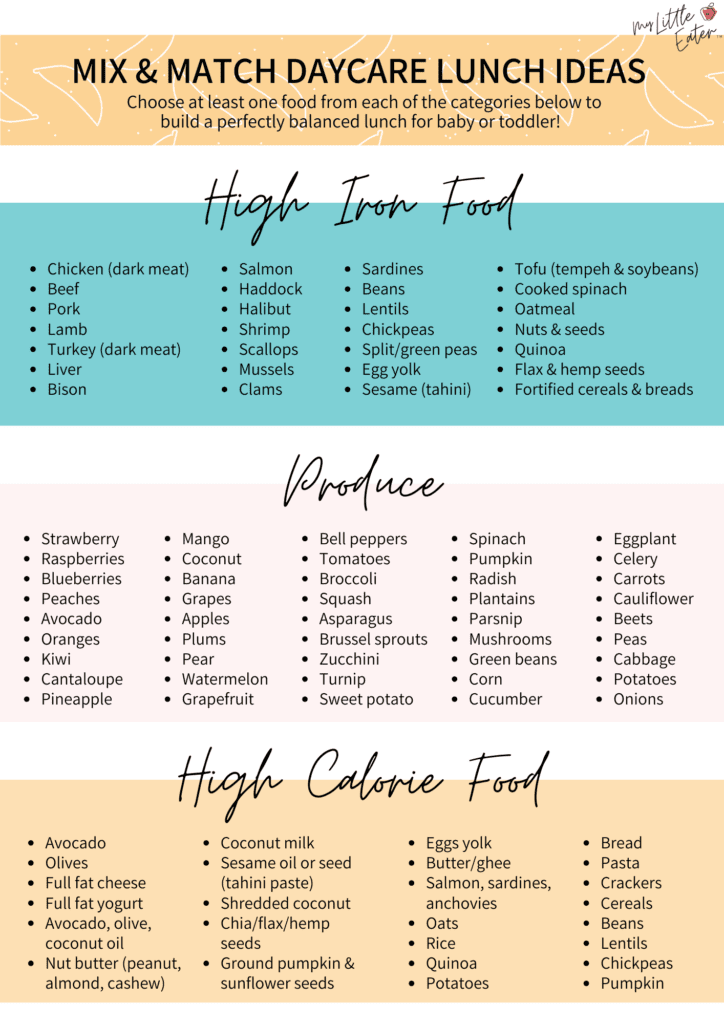
We’ve created this handy mix-and-match list (perfect to stick right on your fridge) for you to refer to every time you have to pack a lunch for your little one. Simply choose one food from each of the categories and ta-da! You can feel good about sending them off to daycare with a balanced meal that will keep them satisfied until dinner time!
And if the meal seems completely random to you – don’t worry! Your baby truly doesn’t care – the nutrition and variety make the meal.
Low-choking risk foods
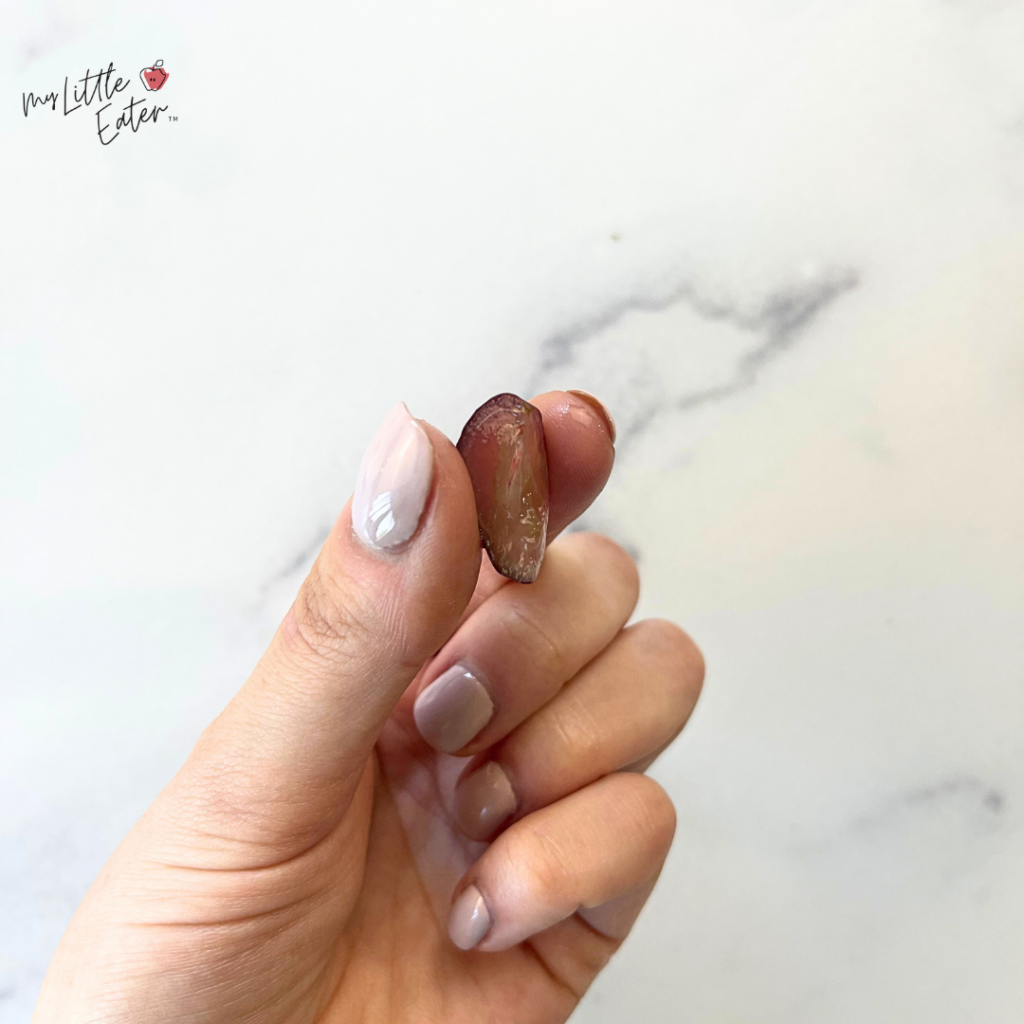
The truth is that anyone can choke, on any type of food, at any age, even when it’s prepared in the safest way possible. This is why it’s extremely important for the caregiver of your child to be trained in infant and child CPR and to ensure a safe eating environment for your baby.
That being said, soft foods like bananas, avocados, mashed sweet potatoes, fluffy pancakes, yogurt, etc. pose a much lower choking risk than foods like popcorn or crackers. You can modify most foods to make them safe for baby and reduce the risk of choking, which should be done at home before you pack the food in your little one’s lunch.
The image below explains how to modify choking hazards for your baby.
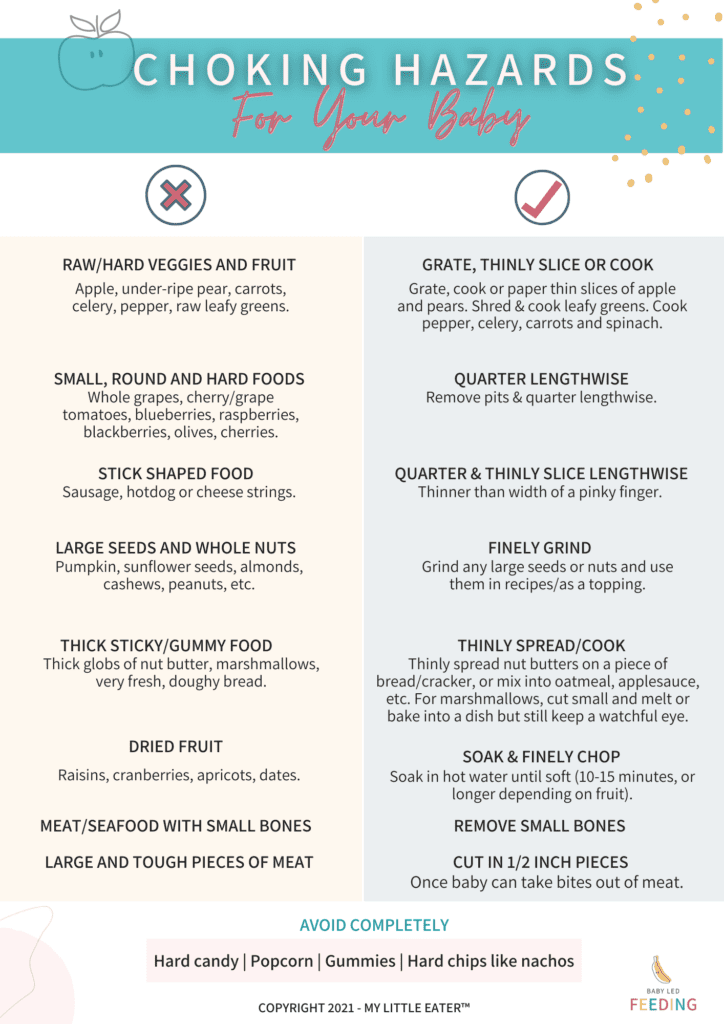
To learn how to safely prepare all foods for your baby, check out our Texture Timeline™ video library inside the Baby Led Feeding online course that allows you to search for any food and see exactly how to serve it based on different phases (difficulty levels) of the Texture Timeline™. New foods are added weekly and you’ll see how babies should be served the food based on your baby’s stage of development, and get tons of nutritional information on each food plus allergy info, fun facts, and more!
20+ best baby led weaning lunch ideas for daycare
Pasta
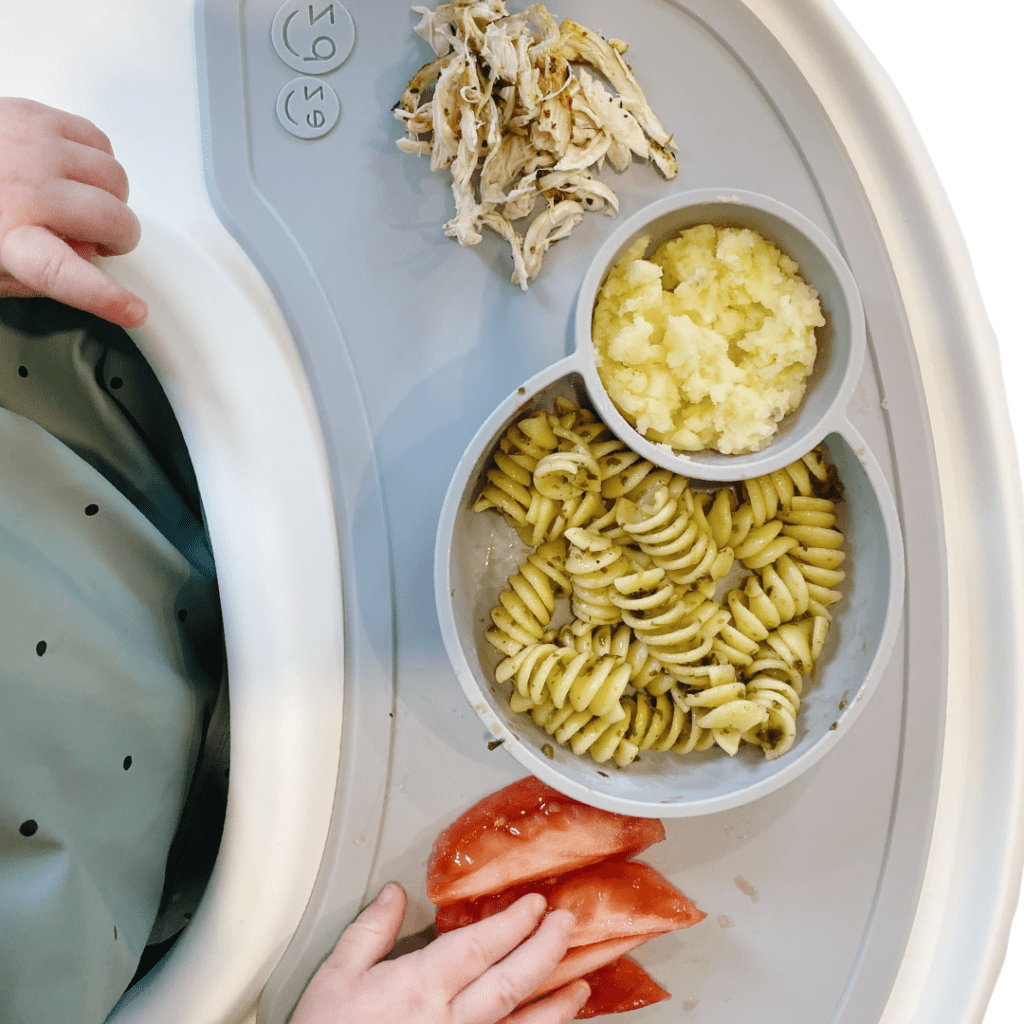
Pasta is a great food to add to your little one’s lunch/bento box, it’s easy to prepare and easy for your baby to pick up with their hands to eat. Toss cooked pasta in any sauce of your choice (pesto or hummus are great options), and pair it with something like cheese or beans, and it easily becomes a full meal. You can also opt to pack pulse-based pasta, such as chickpea pasta for an added protein boost on its own.
Build a balanced meal by adding:
- Produce like tomatoes, broccoli, steamed carrots, or bell peppers
- High-iron food like beef, shredded chicken, or fish
Pasta recipes you’ll love:
- One-pot creamy chicken mushroom orzo pasta
- Penne noodles tossed in low-sodium pesto
Tofu
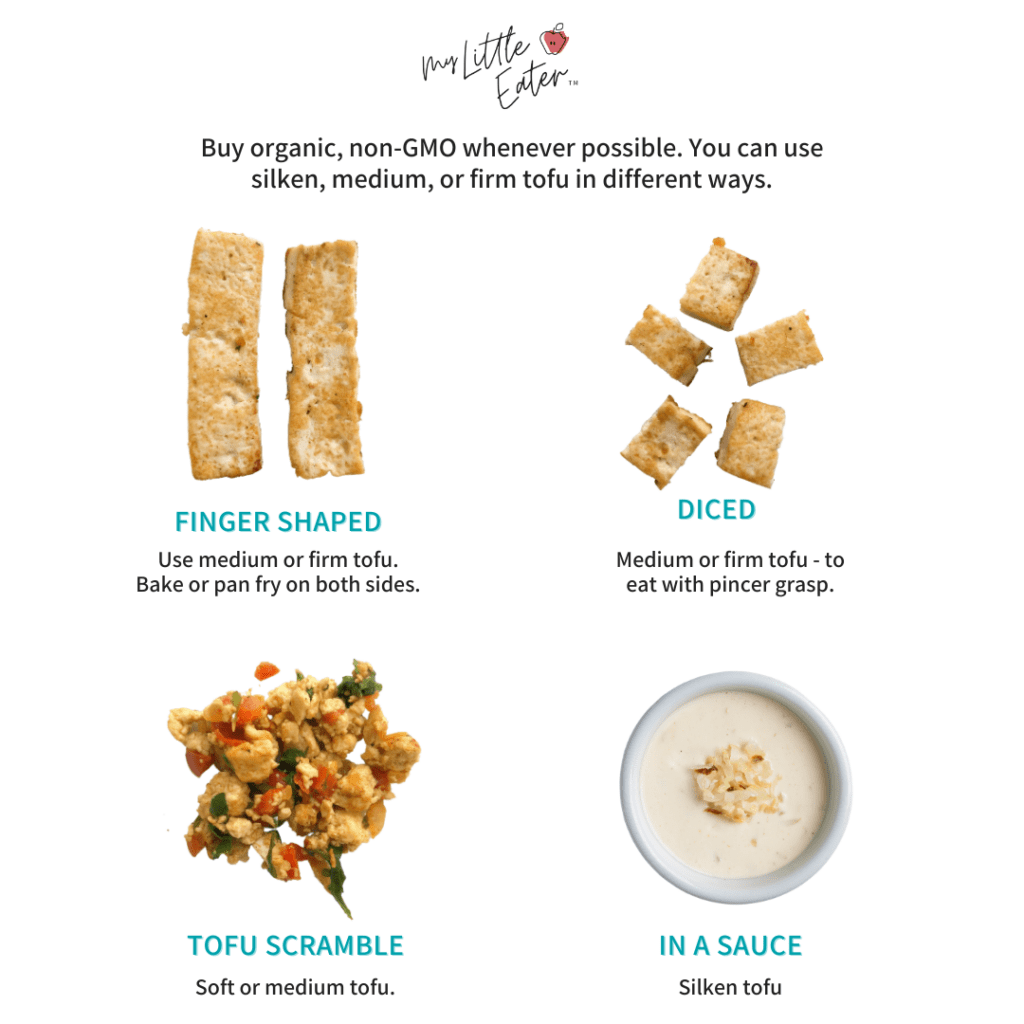
Build a balanced meal by adding:
- Produce like carrots, cooked spinach, or tomatoes
- High-calorie food like pasta, rice, or potatoes
tofu recipe you'll love:
Pouches
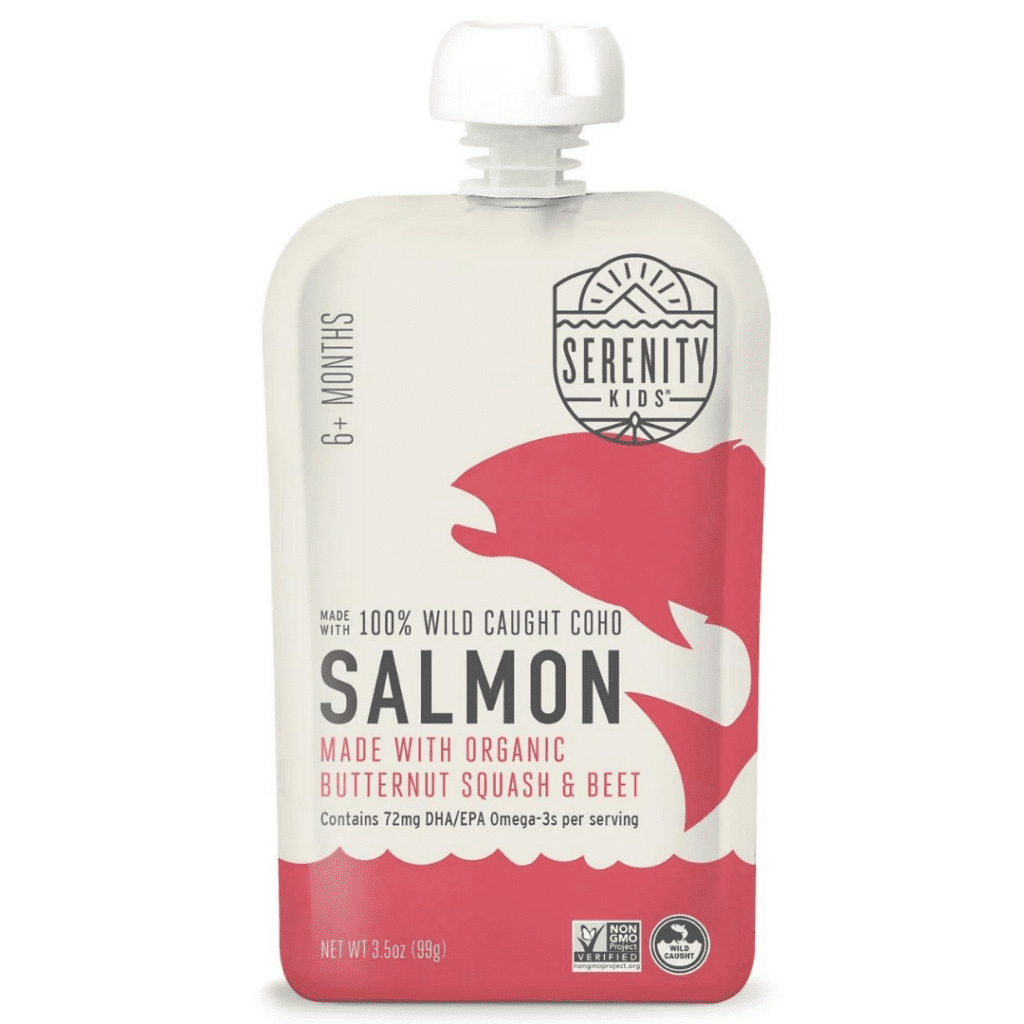
Without a doubt, puree food pouches are the most convenient meals or snacks out there! No mess, no heating, no preparation, and most kids LOVE them. The ingredients found in most food pouches are generally nutritious, but not as nutritious as the food would be in its whole form.
Our official recommendations are to limit food pouches to once per day and only when you really need them. If you truly have no time to prepare your little one’s lunch for one reason or another, it’s ok to send a food pouch every now and again!
We suggest squeezing it out on a spoon when possible or serving it in a bowl and letting baby self-feed. We also don’t want pouches to replace real fruit and veggies, so we recommend getting in the habit of offering one piece of a real fruit or veggie every time you offer a puree pouch!
Build a balanced meal by adding:
Toasted sandwiches
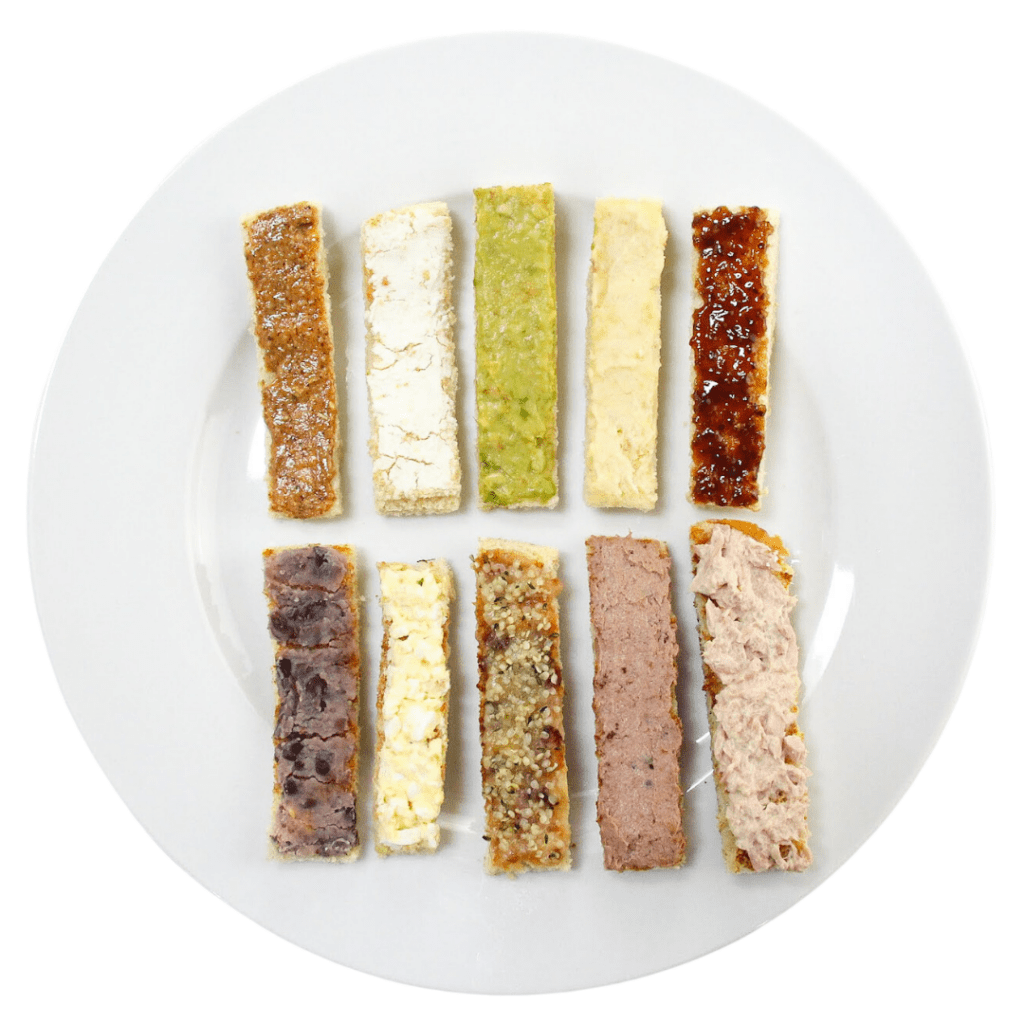
Toasted sandwiches are super easy to make, hold up well in a lunch bag, and there is so much possibility for variety! It’s as simple as toasting bread (coat with a bit of butter to soften slightly), adding a filling of your choice, and then cutting the sandwich into thin strips or bite-sized pieces depending on your baby’s skill level. If you need some inspiration, find 10 healthy toast topping options here.
Remember, fresh, untoasted bread is a choking hazard and shouldn’t be offered until your toddler is at least 18 months of age. If you’re looking for more info on toasting bread for your baby and serving it in a safe manner, check out this post about toast toppings for babies and toddlers.
build a balanced meal by adding:
- High-iron food like beans, salmon, or chicken
- Produce like a banana, peaches, or cooked soft veggies like cauliflower
Amara textured puree mixes
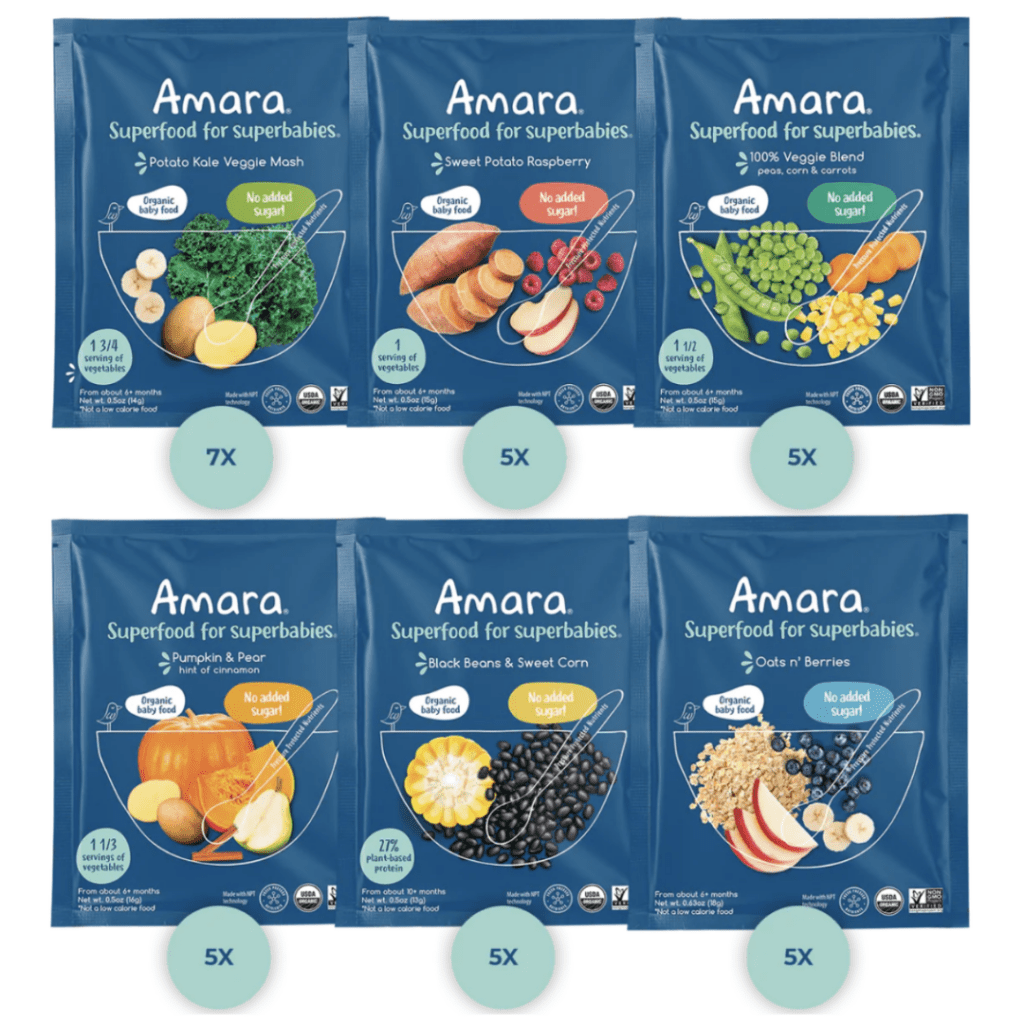
Amara’s textured puree mixes are a nutritious option you can throw in your baby’s lunch bag when you may not have the time to cook! They also have lots of variety packs to choose from, meaning you’ll be able to ensure you’re offering baby a balanced rotation of ingredients. Build a balanced meal by adding a high-iron food like salmon, tofu, or chicken.
They’re perfect for any baby because you can make every food into whatever stage puree you like. All you have to do is adjust the amount of liquid you add to the dehydrated food mix, and get the exact texture you want to work with for your baby!
Variety packs include Introduction to Vegetables, Breakfast Variety Pack, Introduction to Superfruits, Introduction to Solids, and a Veggie Sampler! You can get 15% off your order using code LITTLEEATER.
Roasted or steamed veggies
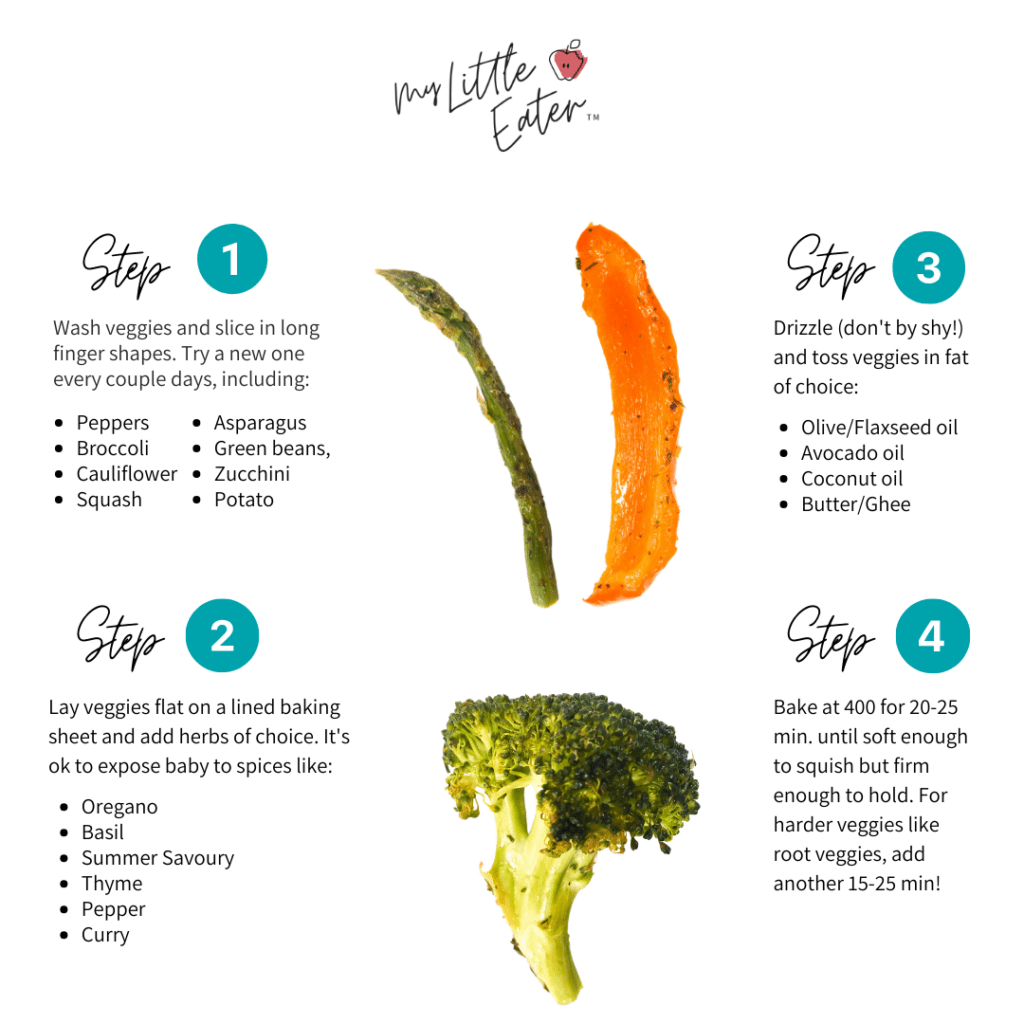
Roasted vegetables can sometimes hold up best when packed in a lunch box (as opposed to in a bag). I suggest that you keep a bunch of roasted veggies prepped ahead of time so that lunches throughout the week will be super easy. Just make a big batch at the beginning of the week of a few different types of veggies, and you’ll be able to pack a different veggie in your little one’s lunch each day. Some good veggies to try roasted are bell peppers, zucchini, broccoli, asparagus, parsnip, eggplant, and carrots.
Other veggies may get softer when steamed and so you may feel safer sending those to daycare. Examples of veggies with a softer texture when they have been steamed include Brussels sprouts, cabbage, broccoli, or cauliflower.
build a balanced meal by adding:
- High-iron food like beans, tofu, or chicken
- High-calorie food like rice (can serve as a rice ball for less mess!), bread, or full-fat dairy (yogurt, cheese, etc.)
Dips
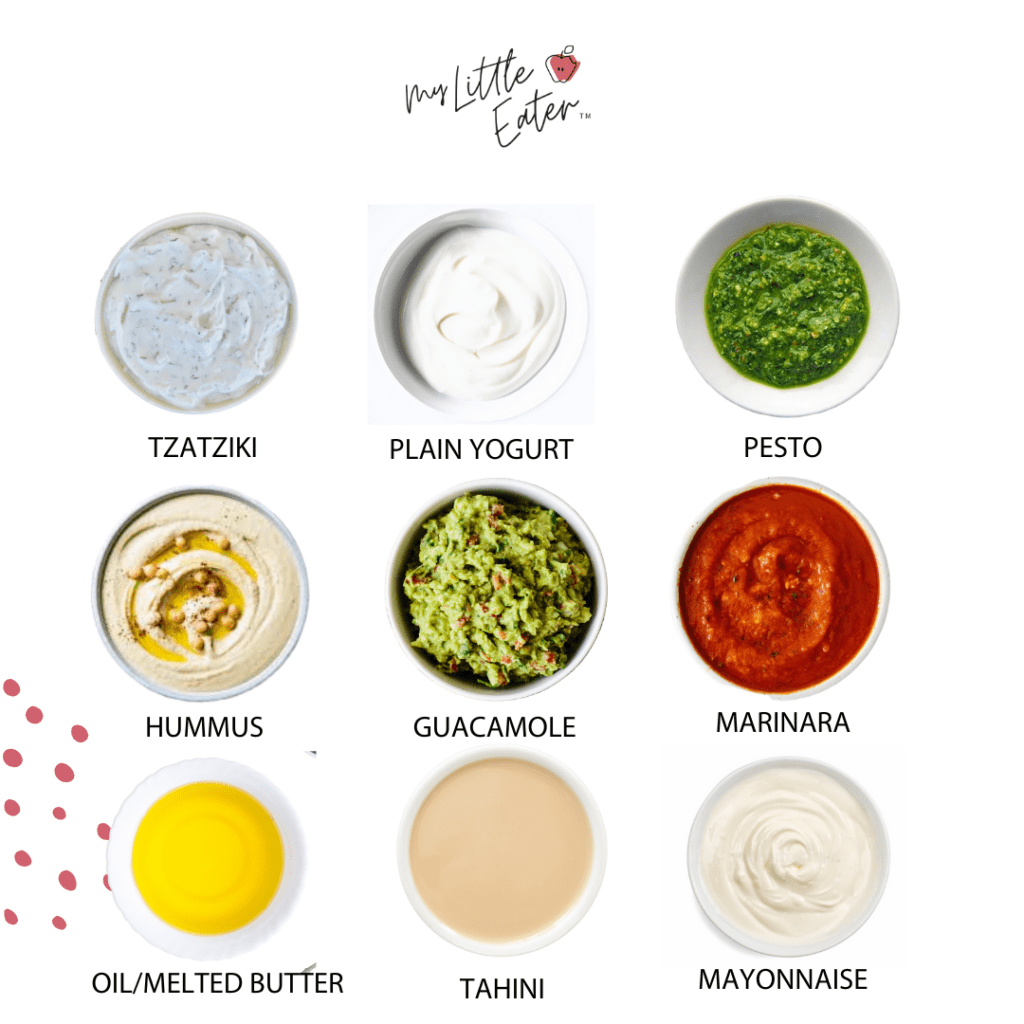
Dips are a great way to help keep food, like meat, moist. They can also be mixed into hard-to-eat foods, like rice or quinoa, in order to make them easier for baby to pick up with their palmar grasp or eat from a pre-loaded spoon (it also minimizes the mess by keeping the loose pieces stuck together).
Rice mixed with guacamole is a perfect example of this! High-fat dips like guacamole and full-fat yogurt are also beneficial for providing a boost of calories for growing babies and toddlers!
build a balanced meal by adding:
- High-iron food like chicken strips, sardines, or eggs
- Produce like green beans, bell peppers, or broccoli
Dip recipes you'll love:
Eggs
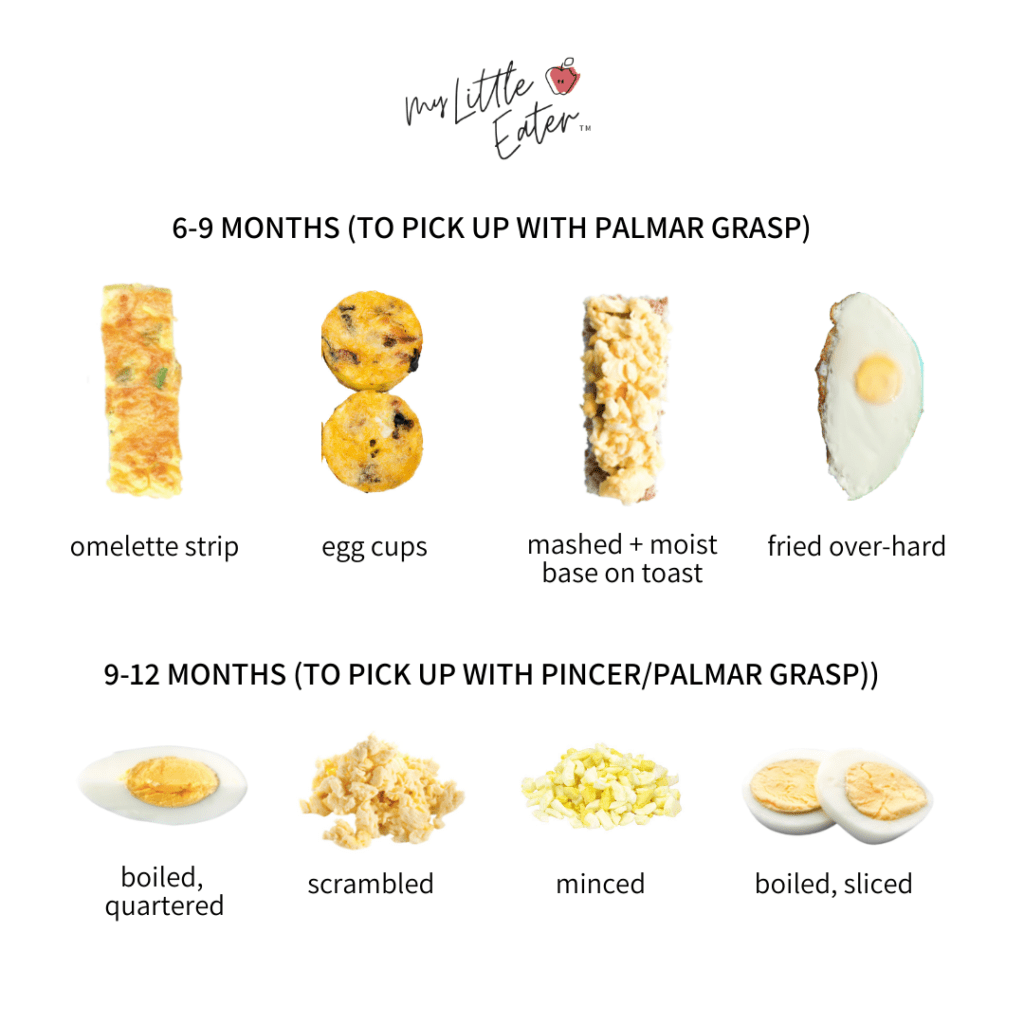
Eggs are a highly versatile and nutritious protein source, making them a great addition to your baby’s lunch. You can serve eggs in a variety of ways, such as hard-boiled egg wedges, omelet strips, scrambled eggs, egg muffins/cups, and more!
build a balanced meal by adding:
- Produce like berries, peppers, or cucumber
- High-calorie food like oats, avocado, or cheese
egg recipe you'll love:
- Baby omelet in a mug and kiwi wedges rolled in coconut
Muffins and cups
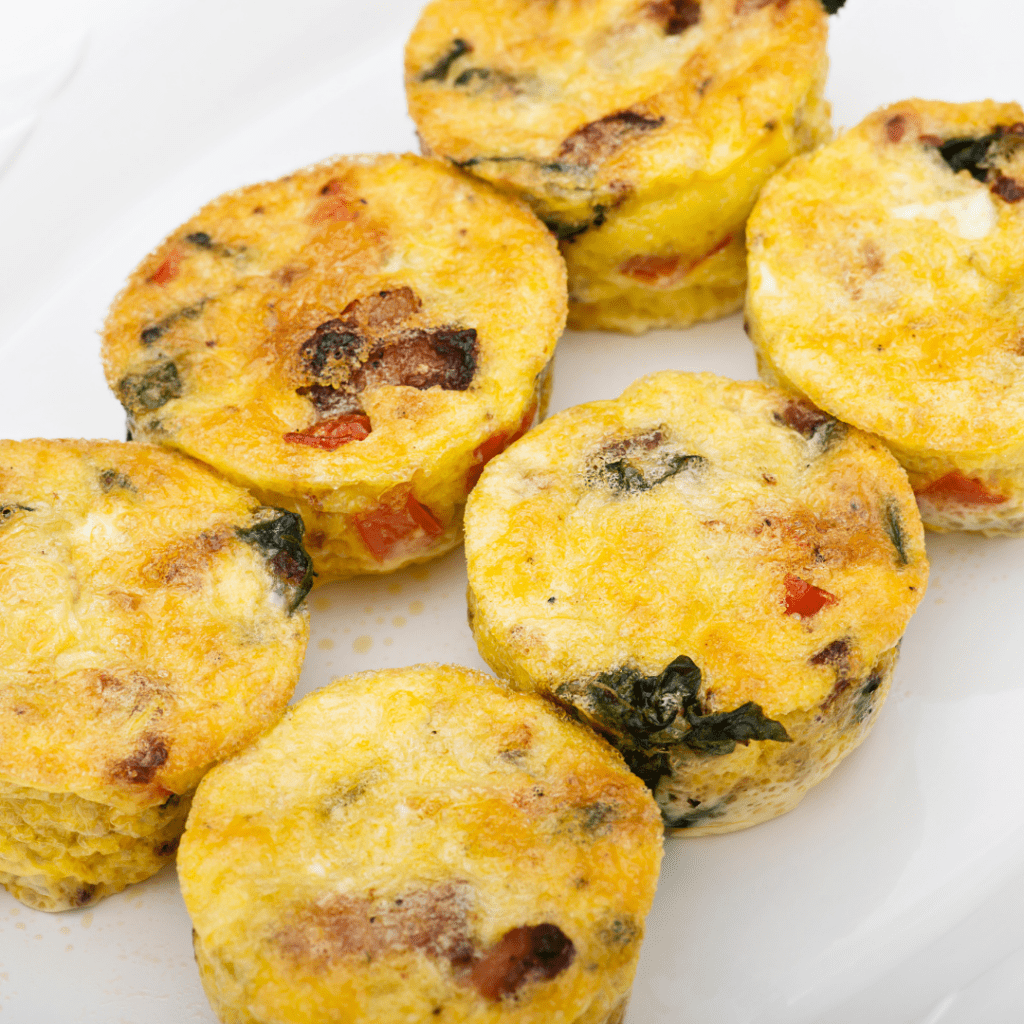
Muffins and similarly shaped foods like egg cups are perfect for your little one’s lunch or bento box! They can pack a punch when it comes to nutrition, plus you can make them in batches, freeze them, and grab one anytime you need it! They hold up perfectly in a lunch box and the flavor combinations are endless!
build a balanced meal by adding:
- Produce like strawberries, bell peppers, or cucumber
- High-iron food like beans, pulled pork, or tofu strips
Muffin recipes you’ll love:
Pancakes and waffles
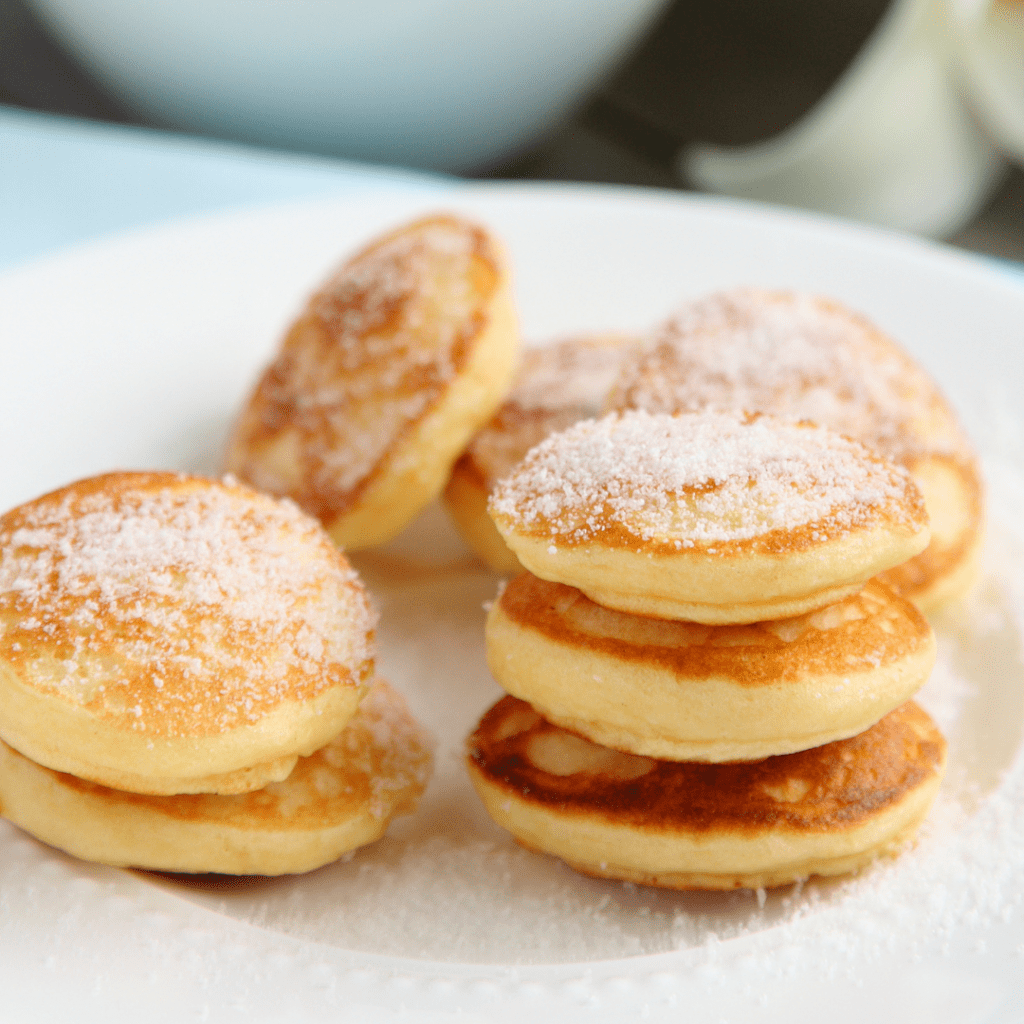
Pancakes and waffles will make for an easy and delicious lunch, even more so when paired with some fresh fruit! And with so many flavor combinations to choose from, your little one will never get tired of seeing these when they open their lunch or bento box.
build a balanced meal by adding:
- High-iron food like beans, tofu, or chicken strips
- Produce like carrots, kiwi, or tomatoes
Pancake and waffle recipe you’ll love:
Beans and chickpeas
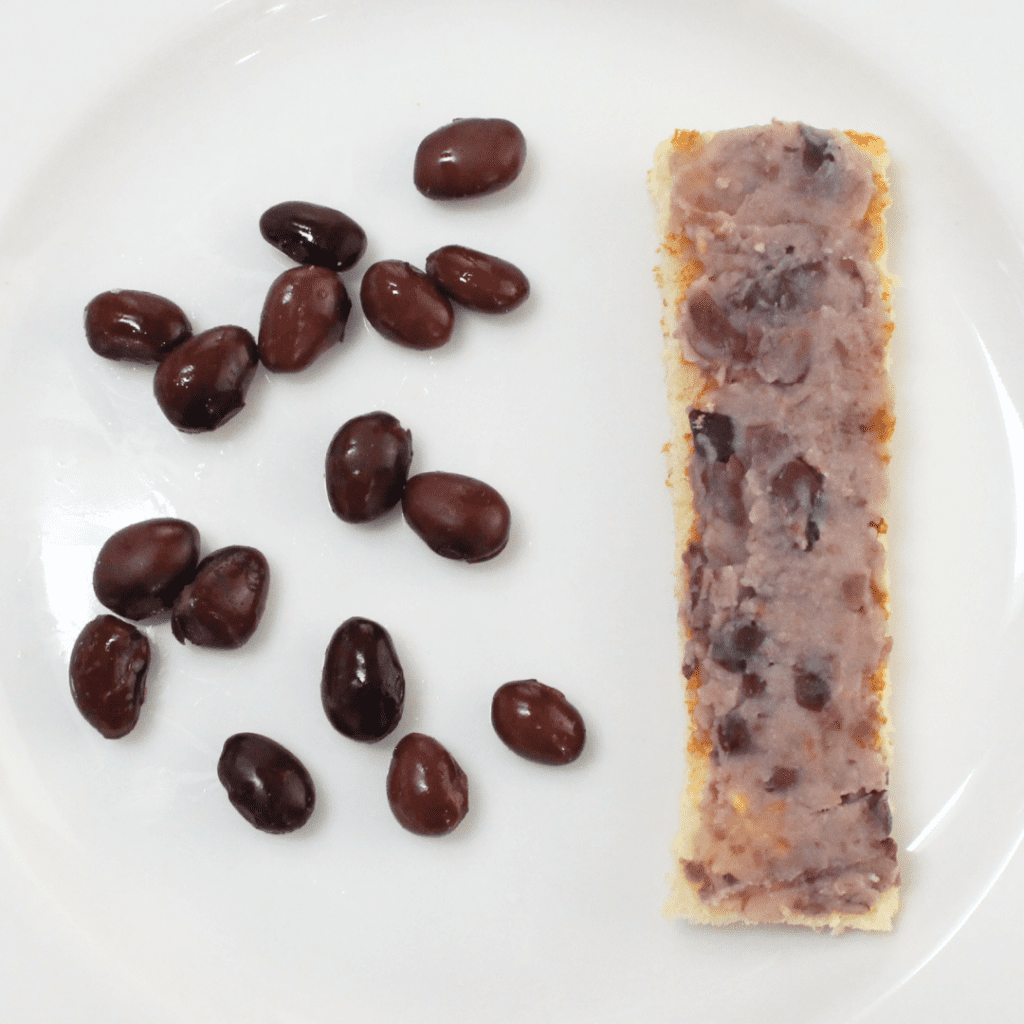
No cooking is needed for this one (but you can if you prefer)!
Just rinse the beans or chickpeas, flatten them with a fork, dump them into a container, and go! If possible, we suggest purchasing ones canned with a BPA-free lining, and that have no added salt because we need to be a bit more cautious when it comes to salt for babies. No need to panic though – if you can’t find any no-salt options, just give them an extra rinse under water before packing them and you’re good to go.
You will want to slightly smush or flatten them with the back of a fork before packing them in your little one’s lunch, just to be safe. Depending on your baby’s skill level, and how soft they are, they can be a choking hazard otherwise.
build a balanced meal by adding:
- Produce like cooked bell peppers, ripe mango, or cooked green beans
- High-calorie food like pasta, avocado, or full-fat dairy (yogurt, cheese, etc.)
bean and chickpea recipes you'll love:
- Chickpea fritters with pineapple rings
- Black bean spread
- Roasted chickpeas
Cheese
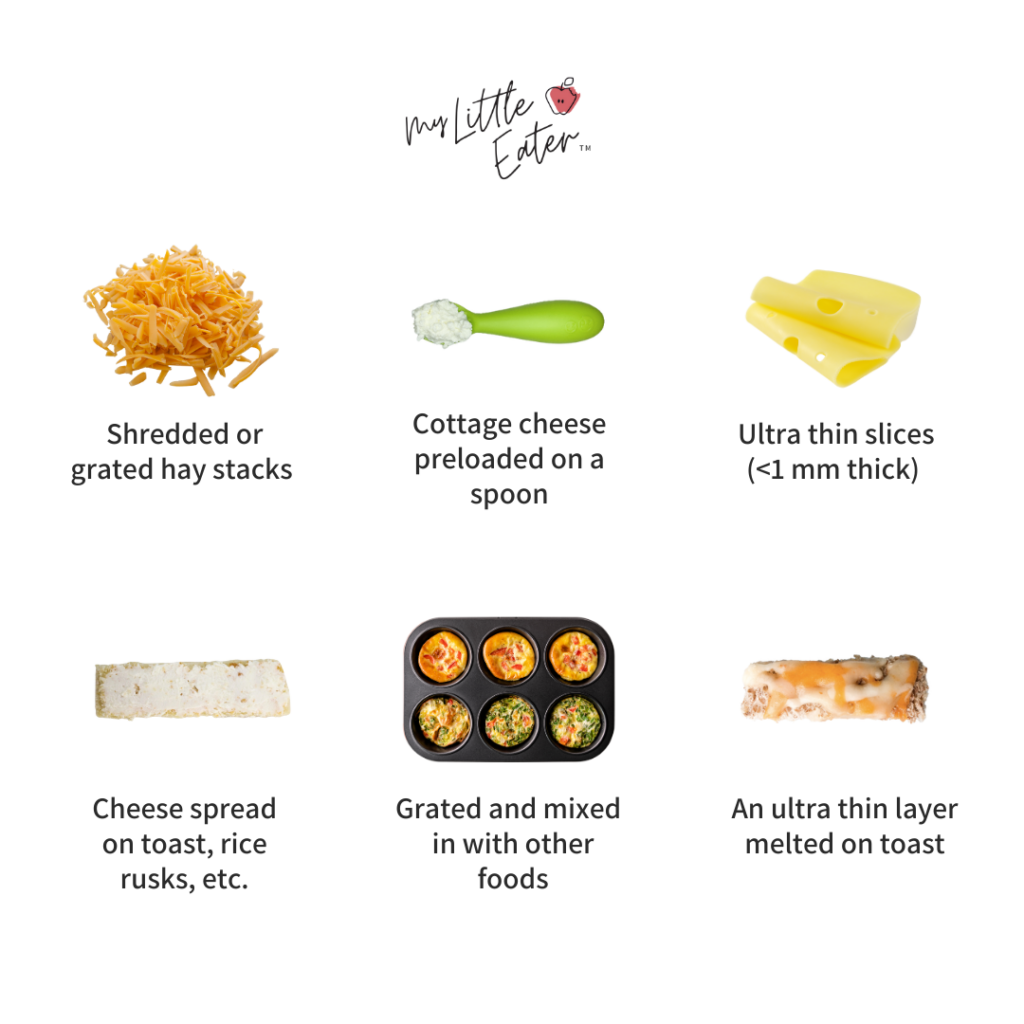
Cheese is a great source of protein for babies, as well as a good source of fat – both of which babies need for proper growth and development. And as an added bonus, it’s usually a favorite amongst most babies!
If your baby is still very young, shredded cheese or ultra-thin slices are the safest recommendations. Thick cheese slices and cheese cubes are a choking hazard for babies, as it can be difficult for babies to move thick pieces of cheese around in their mouth because it can glob together and cubes are the right size and shape to block their airway. You can also take soft cheeses like goat or ricotta and spread them on bread or use them as a dip.
build a balanced meal by adding:
- Produce like zucchini, eggplant, or potatoes
- High-iron food like chicken, beans, or tofu
cheese recipe you'll love:
Meat and fish cakes
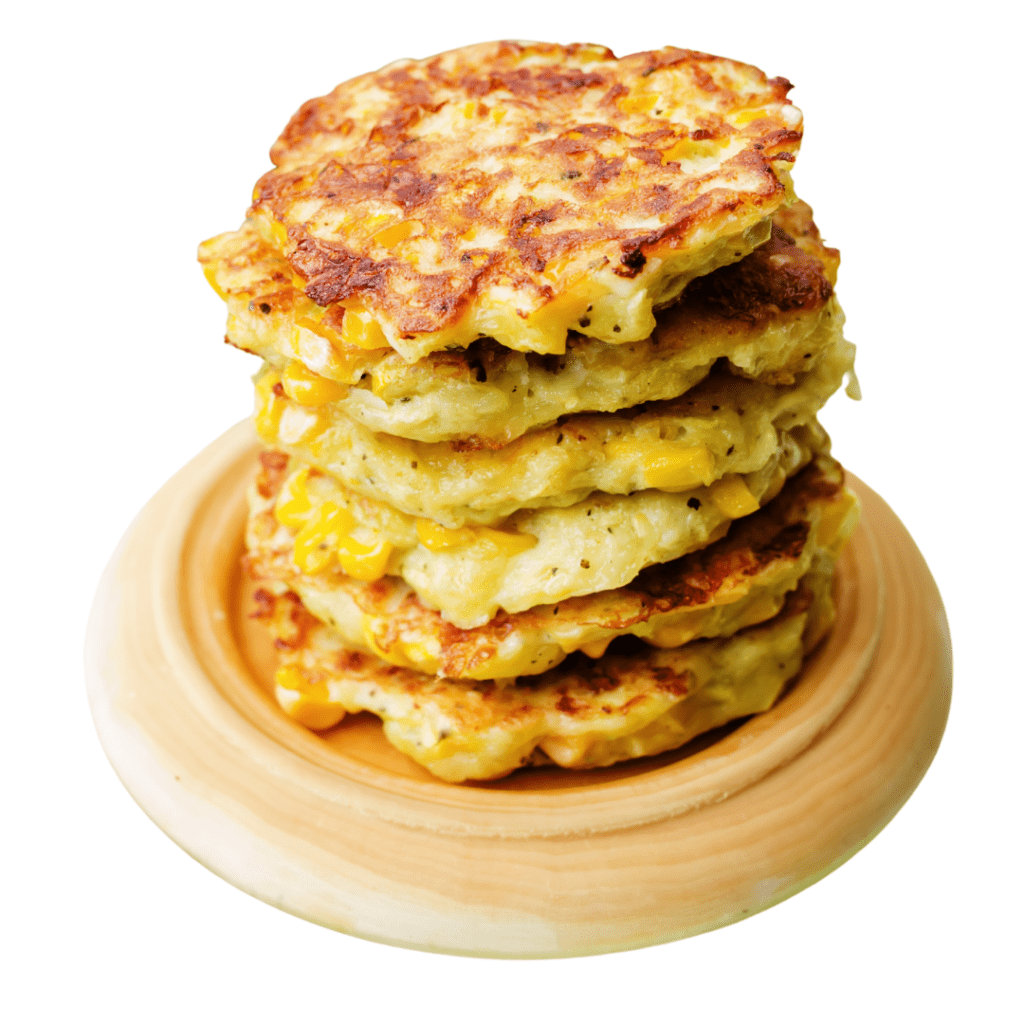
Different types of meat or fish cakes are a great option for babies and toddlers because you can pack a lot of nutrition into a small, easy-to-eat patty! They’re a much better option than ground beef patties or meatballs, in which the meat can be dry and harder to eat. They can be made using simple ingredients of your choice (fish, chicken, various spices, potatoes, etc.). They can also be made in batches, and frozen for later!
build a balanced meal by adding:
- Produce like shredded apples, watermelon, or shaved cucumbers
- High-calorie food like rice, potatoes, or avocado
Fish cake recipe you’ll love:
Bean and Lentil burgers

Burgers made of pulses (like beans, chickpeas, or lentils) are a great nutrient-dense lunch option for babies and toddlers, especially when paired with a vitamin C source to help with iron absorption. These versatile, easy-to-eat patties can also be made in batches and frozen for later as part of your meal prep, they hold up well in a lunch or bento box, and they aren’t too messy for a daycare setting!
build a balanced meal by adding:
- Produce like bell peppers, mango, or strawberries
- High-calorie food like rice, pasta, or full-fat dairy (yogurt, cheese, etc.)
bean burger recipe you'll love:
Smoothie melts
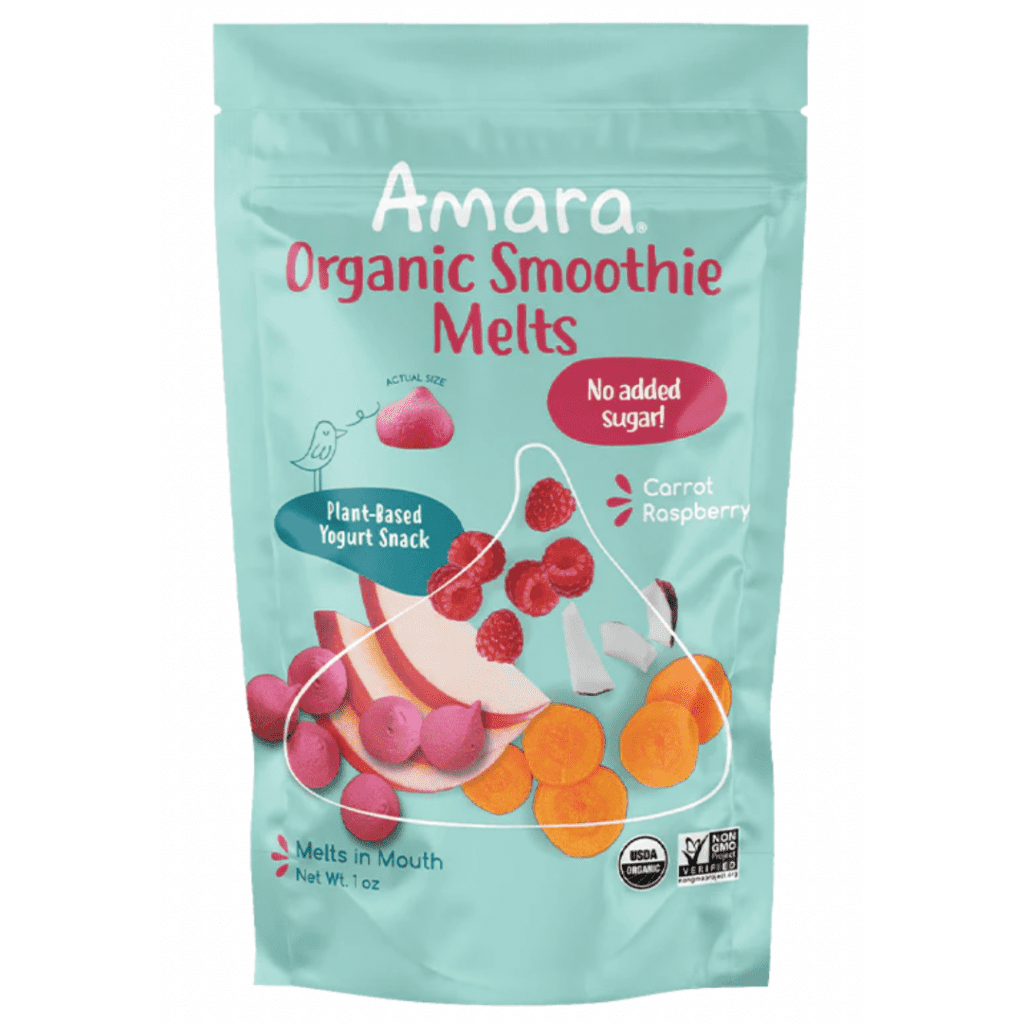
Yogurt-based melts are a perfect alternative to packing actual yogurt because they’re WAY less messy! Our favorites are the Amara Smoothie Melts. These are actually plant-based, so if your little one has an allergy or sensitivity to dairy these will be perfectly fine for them too. They have no added sugars, fillers, or other additives – just simple, clean ingredients – which we love!
They’re also higher in calories compared to other convenient snacks like baby puffs. They come in lots of yummy flavors with various fruits and veggies blended right in and they come in a resealable bag, making them perfect for snacking on the go.
Check them out here and use code LITTLEEATER15 for 15% off your purchase.
build a balanced meal by adding:
- High-iron food like turkey, shrimp, or tofu
- High-calorie food like oatmeal, nut butter, or bread
Pre-cut fruit
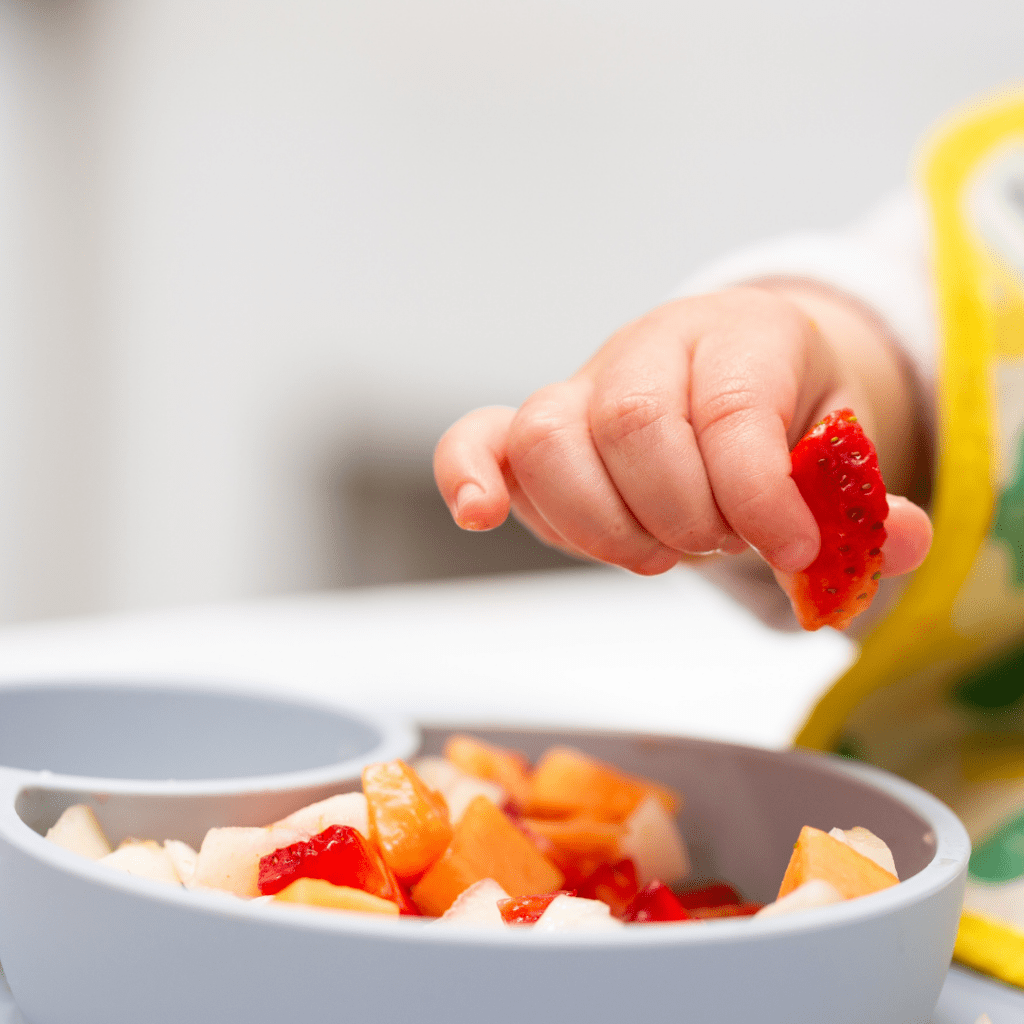
There are fruits that are less messy that you can pack in your little one’s daycare lunch. Stewed pears, apples, or avocados (yes they’re actually a fruit) would be our top choice! Our avocado lunch box hack will come in handy here. The hack is to simply add an oil coating (drizzled from a bottle or sprayed from a can) to half an avocado to prevent browning. They can eat it with a spoon or you can send it in pre-sliced wedges.
You can also do bananas, kiwi wedges, plums, or oranges. These may be ever so slightly messy in that there may be a bit of fruit juice running on your baby’s hands, but nothing a baby wipe can’t handle.
Fruit is an excellent source of vitamin C, and therefore pairs nicely with beans to boost iron absorption – something babies need a lot of! And if you pair that with pasta and shredded cheese, you’ve just easily created a complete, balanced meal that’s perfect for baby led weaning!
build a balanced meal by adding:
- High-iron food like eggs, tofu, or lentils
- High-calorie food like oats, nut butter, or full-fat dairy (yogurt, cheese, etc.)
Smoothies

build a balanced meal by adding:
- High-iron food like tofu strips, beans, or eggs
- High-calorie food like oats, bread, or full-fat dairy (yogurt, cheese, etc.)
smoothie recipes you'll love:
Meat, fish, and egg salads
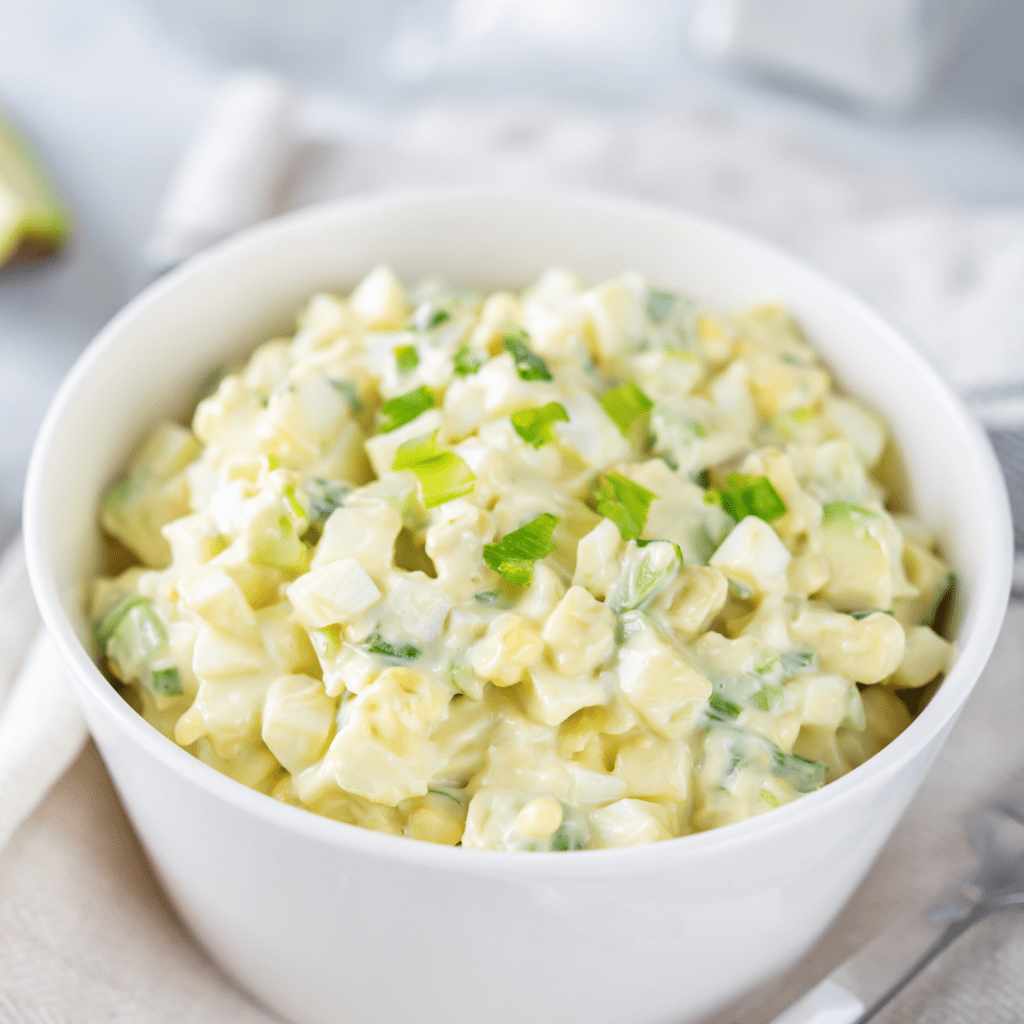
Meat and egg-based salad mixtures are a great option for babies and toddlers as they’re moist, soft, and can be nutrient-dense when mixed with a healthy, high-calorie binder like full-fat yogurt or hummus.
You can serve to baby on a preloaded spoon on its own or spread on toasted bread. Plus, if you’re using meat that you’ve already prepared, this is a super quick lunch meal to put together! For safety and to reduce the risk of choking, offer shredded, slow-cooked meat instead of cubed within the salad mixture.
build a balanced meal by adding:
- Produce like carrots, cooked spinach, or tomatoes
- High-calorie food like pasta, rice, or potatoes
Quesadillas
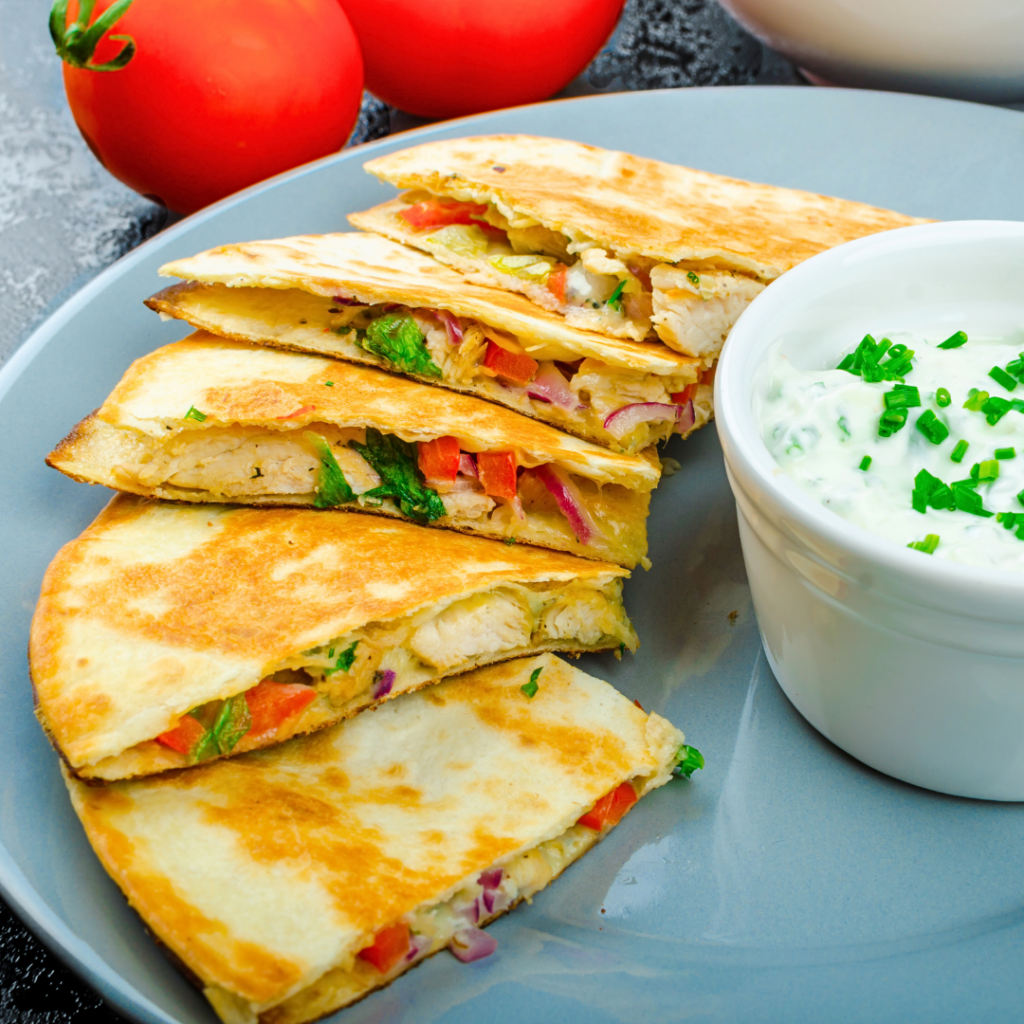
A perfect lunch meal for babies and toddlers that has endless possibilities when it comes to what you can put inside. Change up the filling by using different varieties of beans, cheeses, veggies, and any type of shredded meat. They also hold up pretty well (and aren’t gummy) if they’re toasted and cooled before packing in a lunch box. Not to mention they’re delicious!
Use corn tortillas for babies under 10 months of age, and wheat tortillas after 10 months of age (as they’re a bit more gummy and advanced in texture).
build a balanced meal by adding:
- Produce like berries, peppers, or cucumber
- High-iron food like chicken, beef, or lamb
Oatmeal
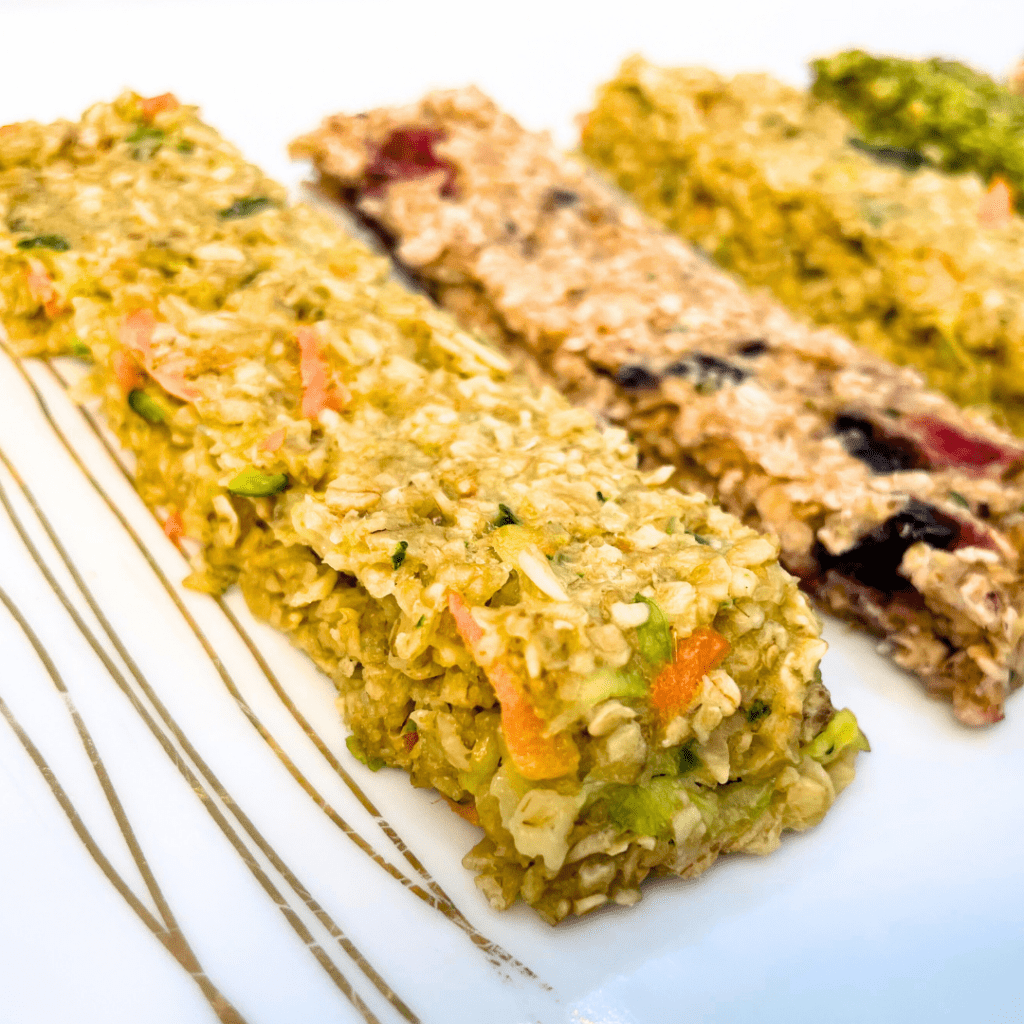
Oatmeal is a great high-calorie food that can be offered in both purée form as a cereal on a spoon, or offered in finger food format by baking into a muffin, forming oats into a ball, or these amazing oatmeal fingers for babies. Don’t worry about serving it warm in a thermos all the time – cold oatmeal is just as good!
You can easily add any mix-in (like unsweetened shredded coconut, hemp seeds, flax seeds, etc.) to oats to boost the nutritional content. There are endless flavor combinations you can create with oatmeal, so if it’s a food you send to daycare often, remember to change up the mix-ins to ensure your little one is getting lots of variety.
If it’s within your means, purchasing certified organic oats will help reduce the amount of glyphosate that your baby is exposed to.
build a balanced meal by adding:
- High-iron food like flax or hemp seeds, cooked spinach, or lentils
- High-calorie food like pumpkin, nut butter, or full-fat dairy (yogurt, cheese, etc.)
Oatmeal recipe you’ll love:
- Banana berry oatmeal fingers with watermelon slices
If you’re looking for more recipe ideas that fall into each of these categories, be sure to check out our 60 Day Baby Led Feeding Meal Plan! We’re currently working on some updates to it and once those are complete the price is going up, so be sure to grab it now and get the updates (with new recipes, grocery lists, and more!) for free when it releases without having to pay the higher price.
Some recipes you’ll find in there that are perfect for daycare lunches as either leftovers or that could be prepared ahead of time are:
- Zucchini Quinoa Fritters & Roasted Butternut Squash
- Broccoli Bites & Tzatziki Dip
- PB & J Overnight Oats with Peaches
- Creamy Spaghetti Squash Casserole
- Chicken Salad on Toast & Cantaloupe
- And so many more!
How to pack your baby or toddler's lunch to send to daycare
First, you’ll want to invest in a good-quality lunch box for your little one. Ideally, something that is air-tight and has different compartments to prevent food or liquid from spilling and/or mixing together. Since it’s an item they’ll be using almost every day, it needs to be durable and functional.
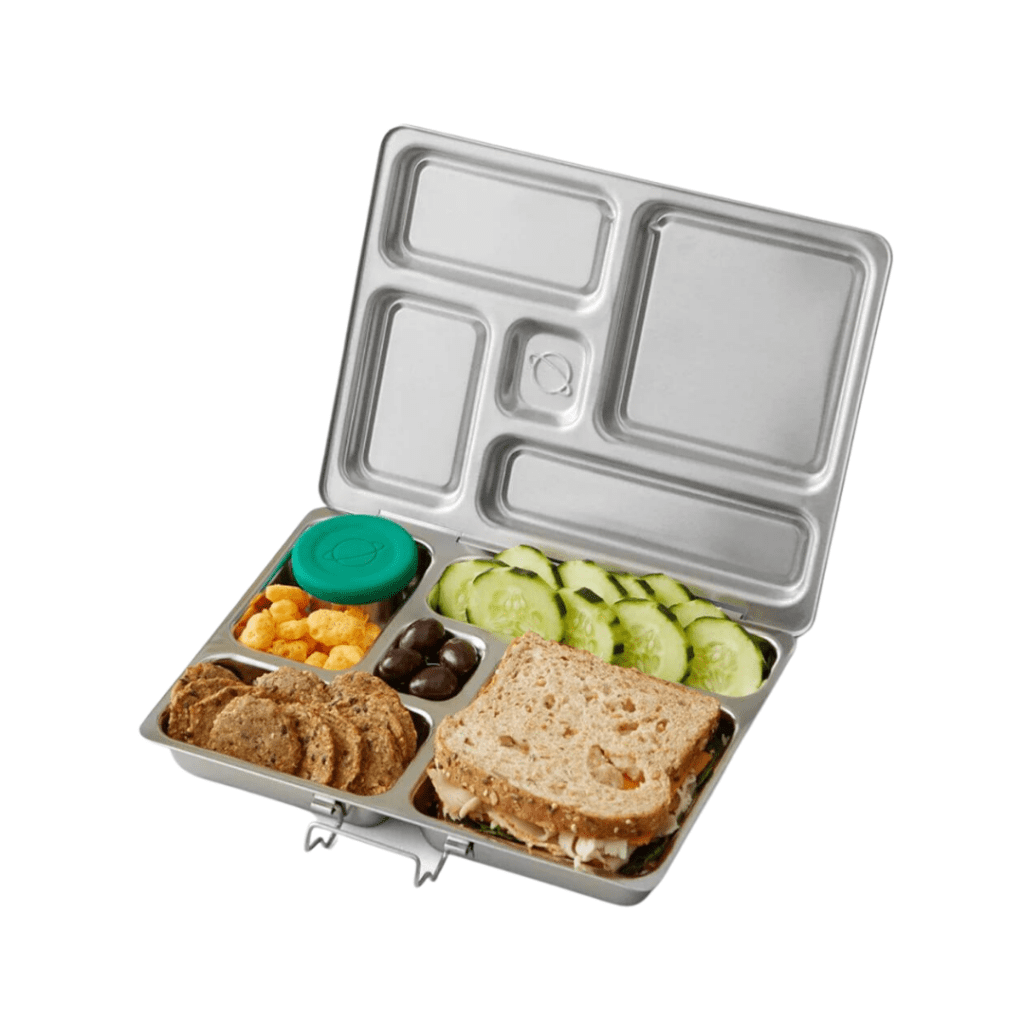
The Planet Box Rover Lunch Box is our absolute favorite ($85 for the complete set – 2 dipping containers, lunch box, carrying bag, and decorative magnets) – yes it’s pricey but it’s truly my favorite for so many reasons! We use it for the adults in the home too as it holds so much!
Check out some other great options, here.
Top tip: If you’re sending this with a toddler or preschooler who may not have the help of a caregiver, practice opening and closing their lunch box, containers, lids, etc. at home before sending them off to daycare to ensure they’re confident and able to do so on their own. This way they won’t be spending time struggling to access their food when they could be spending that time eating.
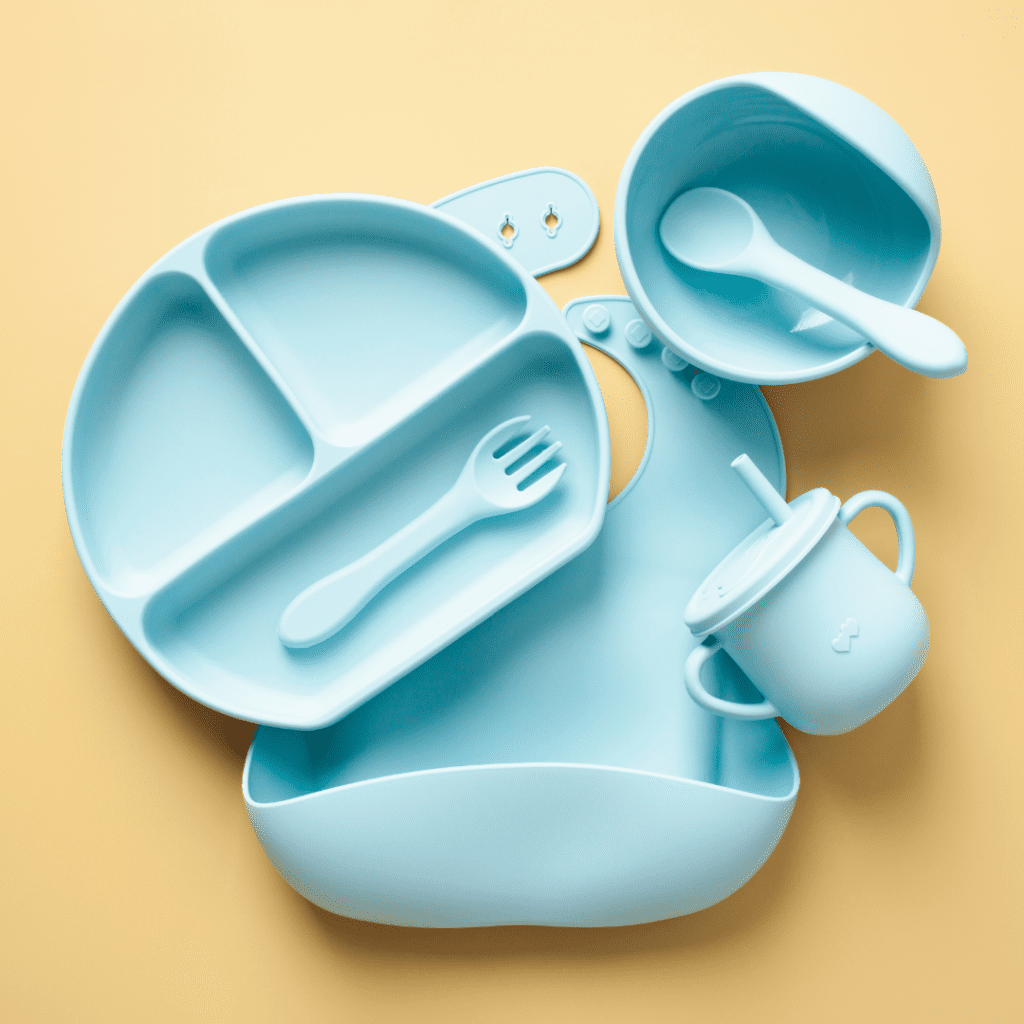
Contact your daycare facility in advance to determine if they’re able to refrigerate, reheat foods, and provide utensils, cups, bibs, and plates for your baby. If not, you’ll need to invest in some additional lunch packing supplies to ensure your little one’s food maintains the proper temperature until they’re ready to eat. Additional feeding gear that may be necessary includes:
- Thermos: if your child’s daycare won’t reheat food. This will help cold foods stay cold and hot foods stay hot, allowing you to send a wider variety of foods in their lunch.
- Ice packs: ideally, you’ll want at least 2 ice packs, on each side of their lunch container to keep things cold. Consider freezing some foods (like pouches, smoothie melts, etc.) to add more coldness to their lunchbox, but test this out at home first to ensure the food will thaw in time for your little one to eat it.
- Feeding gear required for eating that your daycare doesn’t supply for your baby. This could include suction plates if your baby throws their plates/bowls, bibs, baby/toddler-friendly utensils, and cups. You can find all of my favorite feeding supplies, here.
And if you feel like you’re struggling to come up with ideas to create balanced daycare lunches for your baby, don’t forget to grab our baby led feeding meal plan! You’ll get access to over 80 recipes and can follow along with the plan to strategically introduce allergens, advance your baby in textures, and ensure all nutrient needs are being met. The plan is also perfect for the whole family – the recipes are delicious and designed to be able to serve them to everyone in the household – picky toddlers included!

FOUND THIS HELPFUL? PIN IT TO SAVE FOR LATER!
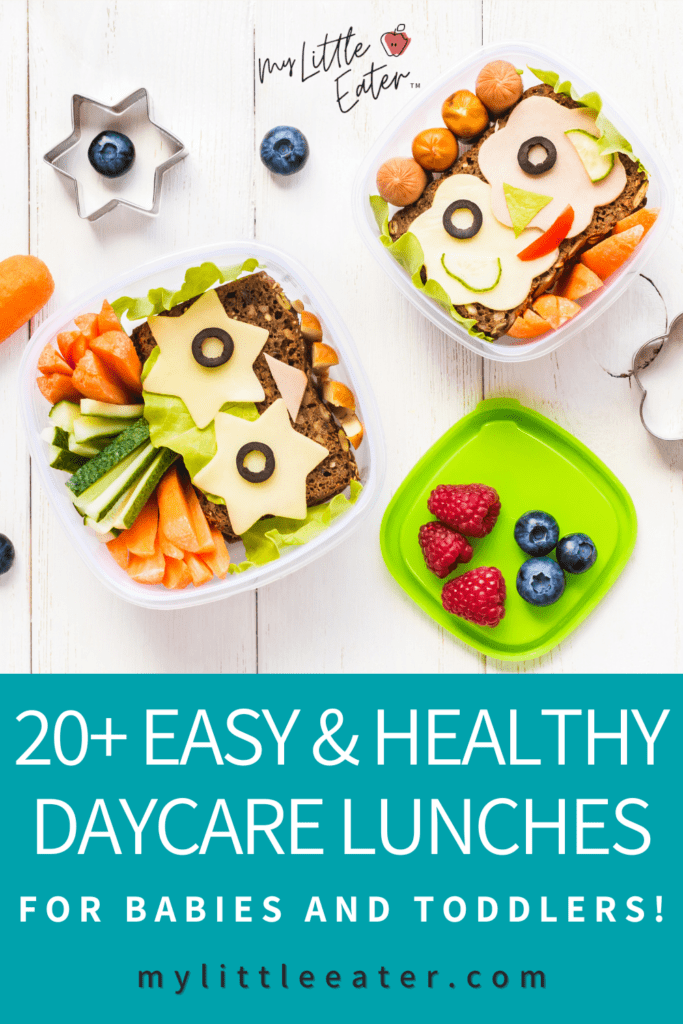

ABOUT THE AUTHOR
CHELSEY LANDRY, RD
Community Dietitian at My Little Eater Inc., and bunny-mom to Hickory. Chelsey offers one-on-one counselling to parents of babies and toddlers that need more customized support. Learn more by booking a free discovery call with her today!

ABOUT THE AUTHOR
CHELSEY LANDRY, RD
Community Dietitian at My Little Eater Inc., and bunny-mom to Hickory. Chelsey offers one-on-one counselling to parents of babies and toddlers that need more customized support. Learn more by booking a free discovery call with her today!








